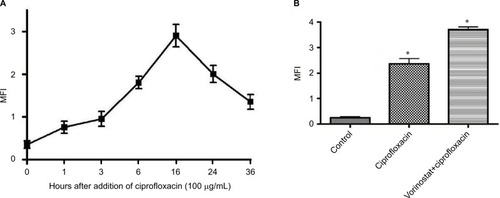Figures & data
Table 1 Comparison between the zones of inhibition (mm) of ciprofloxacin (100 µg/mL) alone and ciprofloxacin with 100 µM vorinostat against standard bacterial strains
Table 2 Comparison between the minimum inhibitory concentrations (MICs; µg/mL) of ciprofloxacin alone and ciprofloxacin in the presence of 100 µM vorinostat against standard bacterial strains
Figure 1 Ciprofloxacin-induced antibacterial action on Escherichia coli cells is preceded by a time-dependent reactive oxygen species (ROS) generation.

